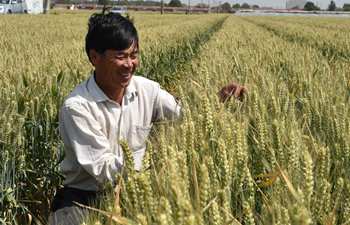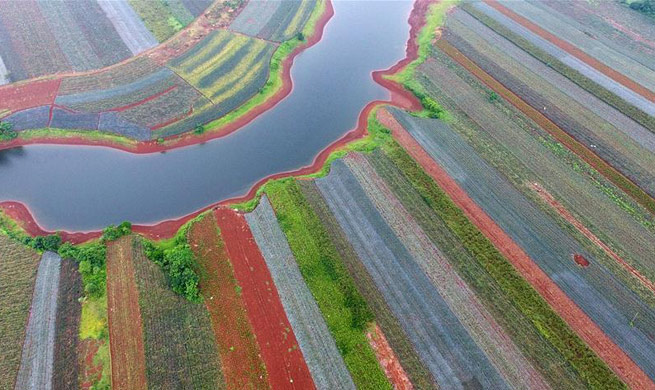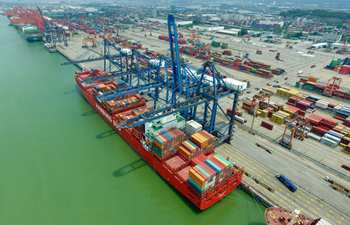by David Musyoka
NAIROBI, May 25 (Xinhua) -- One agricultural think tank in Kenya on Thursday decried rising food commodity prices in the country that it said are among the highest in the world.
Tegemeo Institute of Agricultural Policy and Development of the Egerton University said in a report released in Nairobi that prices of basic food commodities cost more than three times in the local market as compared to the global market.
"A tonne of maize in the local market cost 500 U.S. dollars compared to 150 dollars in the global market. Equally, prices of sugar stand at 1,200 dollars per tonne in Kenya and 400 dollars in the global market," said Timothy Njagi, a research fellow and development economist with Tegemeo Institute.
Njagi added that the high prices in the local market are attributable to low output and high cost of production. Currently, the cost of producing a 90-kg bag of maize stands at 21.5 dollars for small scale farmers and 18 dollars for large scale farmers.
One tonne of sugar cost 600 dollars in Kenya, compared with 350 dollars within the Common Market for Eastern and Southern Africa (COMESA) region.
Denis Otieno, a research fellow with Tegemeo Institute observed that Kenyans are not out of woods yet as current production levels are still low.
"Even the current imports of 100,000 metric tonnes by July will not ease the situation either," said Otieno.
"Currently, the cost of labor is very high going at 30 percent while the cost of fertilizer and harvesting takes up 25 and 22 percent respectively. The recent fall armyworm outbreak has brought about an added cost for farmers who have to buy expensive chemicals to control the pest,'' he said.
Regional Agricultural Trade Intelligence Network (RATIN), a price discovery platform with East African Grain Council (EAGC), indicates that a tonne of maize in Kenya is selling at between 560 dollars and 850 dollars in the wholesale and retail market respectively.
In Uganda the same quantity is retailing at 567 dollars and 510 dollars in wholesale market while in Tanzania, traders are selling the same between 550 and 688 dollars.
According to Kenya's Sugar Directorate Interim Head Solomon Odera, an imported 50-kg bag of sugar is arriving at the Port of Mombasa at 63 dollars while local sugar is retailing at between 68 and 72 dollars.
The think tank warned that the country's food production will decrease further in the next two years owing to effects of climate change, high cost of production and reduced yields in the regional countries.
Njagi said the local market is not benefiting from global prices as it has much protection from foreign competition.
He explained that in the coming years owing to certain underlying factors such as lack of thorough preparedness in terms of taming climate change and value chain weakness, the country's granaries will have less food.
"The interaction between drought, policy and markets has been the major cause of high commodity prices in Kenya. In the next one year, the interface of the same issues will continue and interfere with consumers' purchasing power as the cost of production is expected to remain high and while food productivity will be low," said Njagi.
For example, the country's food production trend has been declining in the last two years owing to numerous gaps along the value chain.
The 2016/2017 production year has been characterized by the prolonged drought which has led to low food production.
For instance, wheat production decreased by 7 percent to 222,000 tonnes, rice output fell by 12 percent to 102,000 tonnes and maize decreased by 14 percent to 37 million bags.
Equally milk production sold to processors also fell from 560,000 liters to 360,000 liters for the same period.
Njagi said the drop in output occasioned an unprecedented price increase of these commodities in the country.
"The government's short-term responses have paid much attention to maize, milk and sugar," said Milton Ayieko, a senior research fellow with Tegemeo Institute.
Kenya remains a net importer of key food staples, including maize, wheat and rice. On average, the country imports over 50 percent of its rice and wheat and 7 to 10 percent of maize needs.
This is despite favorable conditions for production that implies an unexploited potential and lack of sufficient policy support for increased production.
Ayieko said according to projections, maize production is expected to decrease by 11 percent to 32 million bags this year with drought being more severe and intense in future. "There is another alert for La Nina that has been set. We need a more reliable early warning system," said Ayieko.
Njagi said that despite the government fast tracking an ambitious 200-million-dollar fertilizer subsidy program, productivity of maize per acre has decreased to seven bags from 26 bags that is the potential level. The entire program he said requires innovation in order to stimulate more production.
"Declining soil fertility, planting of low quality seeds and poor distribution of rainfall has interrupted the maize potential production rate per acre over the years. Giving fertilizer to farmers can not be construed to mean production will increase. So we need to think of another way to invest so that we can realize more gains,"

















